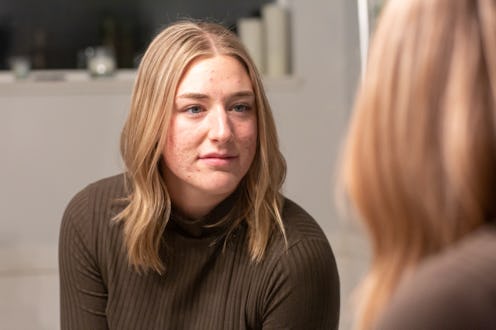Fashion
How To Get Rid Of Cystic Acne, According To Docs

No what matter the cause, an annoying zit can really be a day-wrecking situation no one wants to deal with. And while pimples and zits can surely come in all different shapes and sizes, cystic acne is usually is a condition that’s equal parts frustrating and unbearably painful.
Unlike most pimples, which can sprout up at almost any age, cystic acne proves to be common among teenagers and young adults. Cystic acne is just that: Acne that develops into large, fluid-filled cysts.
“Cystic-acne lesions tend to be deep and very painful,” says Dr. Eric Schweiger, board-certified dermatologist and RealSelf contributor via email. He notes that cystic acne is the least common type, and is seen most often in people with hormonal imbalances.
While hormones, bacteria, and genetics all contribute to cystic acne, there are still plenty of waves to control and treat the condition. I'd advise you speak with a dermatologist in person, who can customize a treatment plan for your specific skin woes. Until you have time to make that appointment, here are some doctor recommended tips for successfully treating cystic acne.
1. Know Your Triggers
Usually affecting those in their early 20s and teens, cystic acne is caused by a combination of bacteria, breakouts, and fluctuating hormones, says Dove dermatologist, Dr. Mona Gohara through email. In result, it’s common to see pimples that are both painful, large, and swollen.
And unlike acne-flare ups that are usually caused when a pore gets clogged with dead skin cells, New York-based dermatologist Dr. David Bank, explains that cystic acne is caused when bacteria gets deep into the pore, and surrounds the hair follicle. Once this happens, the skin starts to produce pus-filled pimples, or cysts.
But aside from clogged pores and bacteria, it’s also important to look out for other triggers that contribute to cystic acne. These include diet, stress, and any additional hormonal aggressors such as PMS.
“PMS, pregnancy, birth control, and stress can all be a trigger,” Dr. Eric Schweiger adds. “There also seems to be a genetic component to factor in as well.” Start keeping a pimple diary (sounds gross, I know) that records what you were eating, how you felt, and if you had your period during each flare up.
2. Get Familiar With Acids
Being that cystic acne mostly appears mostly in the chin and jawline, it’s important to wash your face twice a day. And while there’s lots of cleansers to choose from, it’s best to find products formulated with glycolic or alpha hydroxy acid, as Dr. David Bank finds they are extremely suitable for those with the cystic acne condition.
“Choosing a product with glycolic acid or alpha hydroxy acid is something people with cystic acne should look out for,” Dr Banks says through email. “The alpha hydroxy acid helps open up the pores as it sloughs off dead skin cells, while also moisturizing the skin.”
3. Go Neutral
Neutrogena Deep Clean Scrub, $5, Amazon
In addition to treating your skin with essential acids, using pH neutral products is also recommended. Dr. Mona Gohara finds that they are crucial in cleansing the skin without creating any additional inflammation.
“I prefer a pH neutral non-soap cleanser that won't irritate the already inflamed and tender skin,” Gohara states over email. “The gentle Dove Beauty Bar is always a perfect choice.”
But while most readily-available products have acne-fighting ingredients, there are certain products to cautious of. Some soaps and cleansers can be too harsh on the skin, explains Dr. Gohara, such products can make red and inflamed skin even worse. In addition, Dr. Schweiger warns against using products that can block pores.
“Avoid products that are oil-based or oil-containing, as these can block up pores,” he says. “Also avoid products with petrolatum, such as Vaseline.”
4. Tweak Your Diet
While medications are generally the most effective type of treatment, changing your diet may play a crucial role in managing your cystic acne symptoms as well. For example, high-glycemic foods like rice, white bread, and pretzels can make hormonal spikes worse.
“Cut down on high-glycemic foods as well as dairy,” Schweiger adds. “This is often linked to hormonal influx in the body.”
5. See Your Doctor
While it may be tempting to look up handy holistic approaches online, it’s best to always seek the assistance of a skincare professional, as I mentioned before. Cystic acne can lead to scarring, explains Dr. Schweiger, so it’s best to seek professional help before trying any new remedies you’re not familiar with.
Treatment can vary from patient to patient, so it’s best to talk to your doctor first, to find out which is right for you. Medications can also be prescribed, but it’s best to talk about this sort of treatment with a dermatologist, before trying them yourself.
“Oral antibiotics, hormonal therapies like spironolactone and Accutane can all be used in cystic acne treatment,” says Dr. Schweiger. “But, it is best to see a dermatologist to determine the right treatment for you.”
Images: Barcroft Media/Barcroft Media/Getty Images; Giphy